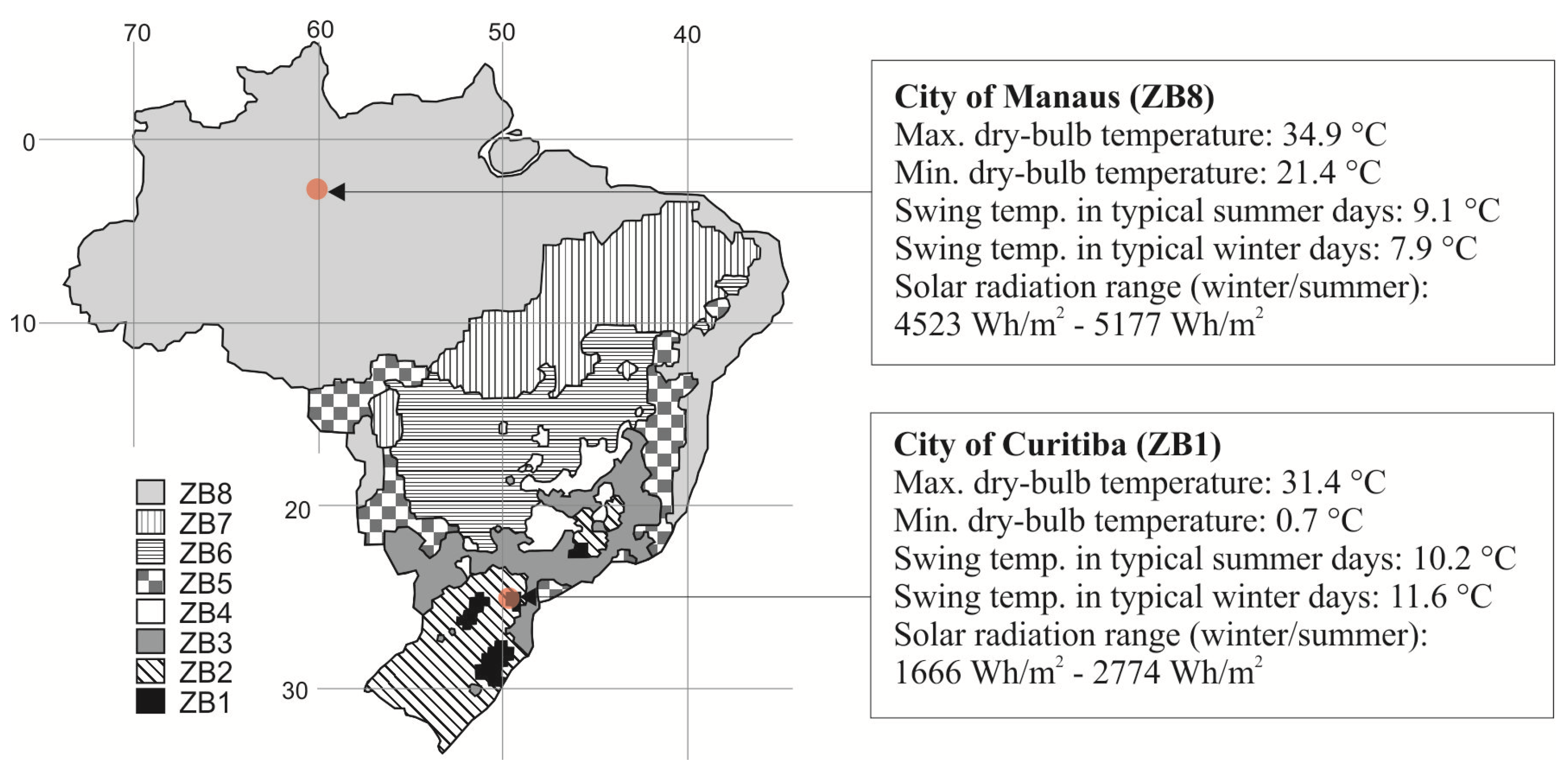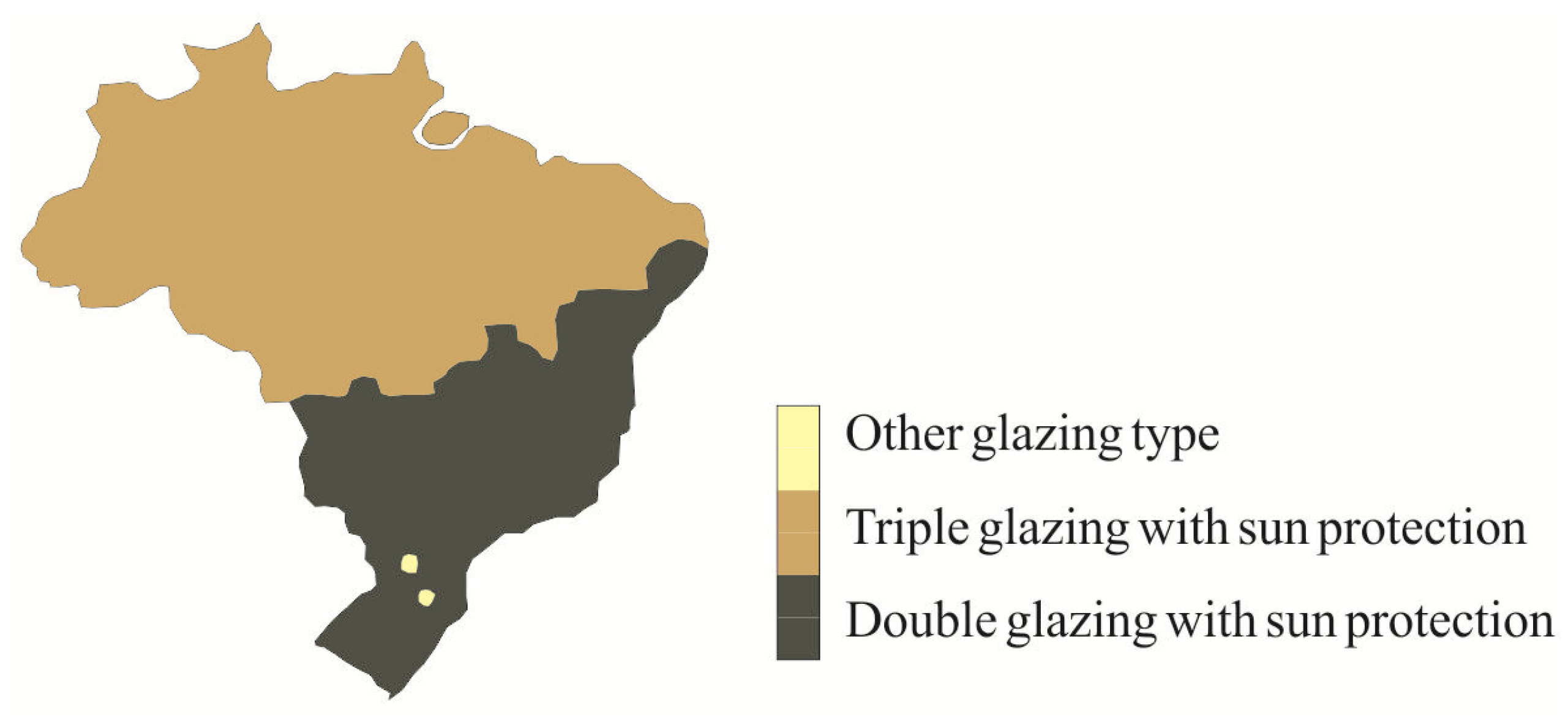A Comparative Study of the Brazilian Energy Labelling System and the Passivhaus Standard for Housing
Abstract
:1. Introduction
2. The Brazilian Regulations and Standards

3. The Passivhaus Standard
4. The Comparison Methodology
5. The RTQ-R Label vs. the Passivhaus Standard
5.1. Primary Energy Demand
5.2. Space Heating or Cooling Demand and Heating or Cooling Load
5.3. Insulation—Glazing Areas and Opaque Elements


| Requirement | Passivhaus Standard | RTQ-R label |
|---|---|---|
| Nature of standard | Indoor thermal comfort with minimum energy input | Building Energy saving |
| Primary energy demand | ≤120 kW·h/m2·a | There are no requirements because the standard encourages bioclimatic strategies. |
| Heating or Cooling demand | ≤15 kW·h/m2·a | |
| Heating or Cooling load | ≤ 10W/m2 | |
| Airtightness | ≤0.6 air changes at 50 Pa | There is no requirement because it adopts natural ventilation. |
| U-value wall | ≤0.15 W/m2·K | ≤2.5 W/m2·K for ZB1-ZB2; ≤3.7 W/m2·K when absorptance (α) ≤ 0.6 or ≤ 2.5 W/m2·K when α > 0.6 for ZB3-ZB8 |
| U-value roof | ≤0.15 W/m2·K | ≤2.3 W/m2·K for ZB1-ZB2; ≤2.3 W/m2·K when α ≤ 0.6 or ≤ 1.5 W/m2·K when >0.6 for ZB3-ZB6; ≤2.3 W/m2·K when α ≤ 0.4 or ≤ 1.5 W/m2·K when >0.4 for ZB7-ZB8 |
| U-value glazing | ≤0.80 W/m2·K | There is no requirement. |
| Ventilation system | Mechanical ventilation system | Natural ventilation |
| Windows | Glazing area: 20% of floor area south-oriented and 5% of floor north-oriented for energy balance | Opening area: ≥5% of floor area for ZB7, ≥8% of floor area for ZB1-ZB6; ≥10% of floor area for ZB8 |
| Method of analysis | Energy balance method | Simulation or prescriptive method |
| Software | Passivhaus Planning Package (PHPP); it is based on steady state calculations. | It has to comply with ASHARE Standard 140 (2007); it is based on dynamic building simulations. |
| Comfort temperature | 20 °C for winter; 25 °C for summer and 26 °C ≤60% RH for summer | 26 °C for summer |
5.4. Airtightness and Ventilation
5.5. Simulation Software and Comfort Criterion
6. Conclusions
Acknowledgments
Author Contributions
Conflicts of Interest
References
- Empresa de Pesquisa Energética. Nota técnica DEA 28/13: Projeção da demanda de energia elétrica para os próximos 10 anos (2014–2023). In Estudos Da Demanda; (In Portuguese). EPE: Rio de Janeiro, Brazil, 2013. [Google Scholar]
- Empresa de Pesquisa Energética. Brazilian Energy Balance 2013 Year 2012; EPE: Rio de Janeiro, Brazil, 2013. [Google Scholar]
- Pfeiffer, M.O. Passos para cumprir uma agenda verde. Valor Setorial: Construção Civil; Valor Econômico: São Paulo, Brazil, 2011; pp. 8–14. Available online: http://www.revistavalor.com.br/home.aspx?pub=57&edicao=2 (accessed on 16 May 2014). (In Portuguese)
- Empresa de Pesquisa Energética. Brazilian Energy Balance 2012 Year 2011; EPE: Rio de Janeiro, Brazil, 2012. [Google Scholar]
- Centrais Elétricas Brasileiras S. A. (ELETROBRAS); Programa Nacional de Conservação de Energia Elétrica (PROCEL). Avaliação do Mercado de Eficiência Energética no Brasil: Pesquisa de Posse de Equipamentos e Hábitos de Uso-Ano Base 2005; (In Portuguese). ELETROBRAS, PROCEL: Rio de Janeiro, Brazil, 2007. [Google Scholar]
- Ghisi, E.; Gosch, S.; Lamberts, R. Electricity End-Uses in the Residential Sector of Brazil. Energy Policy 2007, 35, 4107–4120. [Google Scholar] [CrossRef]
- Instituto Brasileiro de Geografia e Estatística. Pesquisa Anual da Indústria da Construção; (In Portuguese). IBGE: Rio de Janeiro, Brazil, 2011; pp. 1–98. [Google Scholar]
- Carbon Trust. Brazil the 200 Billion Low Carbon Opportunity; Carbon Trust: London, UK, 2012. [Google Scholar]
- Associação Brasileira de Normas Técnicas. NBR 15220–1: Desempenho Térmico de Edificações-Parte 1: Definições, Símbolos e Unidades; (In Portuguese). ABNT: Rio de Janeiro, Brazil, 2005. [Google Scholar]
- Associação Brasileira de Normas Técnicas. NBR 15220–2: Desempenho Térmico de Edificações-Parte 2: Métodos de Cálculo da Transmitância Térmica, da Capacidade Térmica, do Atraso Térmico e do Fator Solar de Elementos e Componentes de Edificações; (In Portuguese). ABNT: Rio de Janeiro, Brazil, 2005. [Google Scholar]
- Associação Brasileira de Normas Técnicas. NBR 15220–3: Desempenho Térmico de Edificações-Parte 3: Zoneamento Bioclimático Brasileiro e Diretrizes Construtivas Para Habitações Unifamiliares de Interesse Social; (In Portuguese). ABNT: Rio de Janeiro, Brazil, 2005. [Google Scholar]
- Associação Brasileira de Normas Técnicas. NBR 15220–4: Desempenho Térmico de Edificações-Parte 4: Medição da Resistência Térmica e da Condutividade Térmica Pelo Princípio da Placa Quente Protegida; (In Portuguese). ABNT: Rio de Janeiro, Brazil, 2005. [Google Scholar]
- Associação Brasileira de Normas Técnicas. NBR 15220–5: Desempenho Térmico de Edificações-Parte 5: Medição da Resistência Térmica e da Condutividade Térmica Pelo Método Fluximétrico; (In Portuguese). ABNT: Rio de Janeiro, Brazil, 2005. [Google Scholar]
- Associação Brasileira de Normas Técnicas. NBR 15575–1: Edificações Habitacionais-Desempenho-Parte 1: Requisitos Gerais; (In Portuguese). ABNT: Rio de Janeiro, Brazil, 2013. [Google Scholar]
- Associação Brasileira de Normas Técnicas. NBR 15575–2: Edificações Habitacionais-Desempenho-Parte 2: Requisitos Para os Sistemas Estruturais; (In Portuguese). ABNT: Rio de Janeiro, Brazil, 2013. [Google Scholar]
- Associação Brasileira de Normas Técnicas. NBR 15575–3: Edificações Habitacionais-Desempenho-Parte 3: Requisitos Para os Sistemas de Pisos; (In Portuguese). ABNT: Rio de Janeiro, Brazil, 2013. [Google Scholar]
- Associação Brasileira de Normas Técnicas. NBR 15575–4: Edificações Habitacionais-Desempenho-Parte 4: Requisitos Para os Sistemas de Vedações Verticais Internas e Externas-SVVIE; (In Portuguese). ABNT: Rio de Janeiro, Brazil, 2013. [Google Scholar]
- Associação Brasileira de Normas Técnicas. NBR 15575–5: Edificações Habitacionais-Desempenho-Parte 5: Requisitos Para os Sistemas de Coberturas; (In Portuguese). ABNT: Rio de Janeiro, Brazil, 2013. [Google Scholar]
- Instituto Nacional de Metrologia, Normalizaçao e Qualidade Industrial. Regulamento Técnico da Qualidade Para o Nível de Eficiência Energética Edificações Residenciais (RTQ-R). Portaria n. 18, de 16 de janeiro de 2012; (In Portuguese). INMETRO: Rio de Janeiro, Brazil, 2012. [Google Scholar]
- Scalco, V.A.; Fossatia, M.; de Souza Versagea, R.; Sorgatoa, M.J.; Lambertsa, R.; Morishitaa, C. Innovations in the Brazilian regulations for energy efficiency of residential buildings. Arch. Sci. Rev. 2012, 55, 71–81. [Google Scholar] [CrossRef]
- Zero Carbon Hub and NHBC Foundation. Mechanical Ventilation with Heat Recovery in New Homes—Interim Report—Ventilation and Indoor Air Quality Task Group; Zero Carbon Hub: Milton Keynes, UK, 2012. [Google Scholar]
- Sands, P.; Galizzi, P. Directive 2002/91/EU of the European parliament and of the council of 16 December 2002 on the energy performance of buildings. In Documents in European Community Environmental Law; Cambridge University Press: Cambridge, UK, 2002. [Google Scholar]
- Directive 2010/31/EU of the European Parliament and of the Council of 19 May 2010 on the energy performance of buildings (recast). Available online: http://eur-lex.europa.eu/LexUriServ/LexUriServ.do?uri=OJ:L:2010:153:0013:0035:EN:PDF (accessed on 18 June 2010).
- Szokolay, S. Introduction to Architectural Science: The Basis of Sustainable Design; Architectural Press: London, UK, 2008. [Google Scholar]
- Department for Communities and Local Government. 2012 Consultation on Changes to the Building Regulations in England: Section Two-Part L (Conservation of Fuel and Power)—Proposed Changes to Technical Guidance; Department for Communities and Local Government: London, UK, 2012. [Google Scholar]
- Cotterel, J.; Dadeby, A. The Passivhaus Handbook: A Practical Guide to Constructing and Retrofitting for Ultra-Low Energy Performance; Green Books: Devon, UK, 2012. [Google Scholar]
- Decreto Lei 80/2006. Decreto Lei 80/2006 de 4 de Abril—Regulamento das Características de Comportamento Térmico dos Edifícios (RCCTE); Diário da República: Portugal, 2006; pp. 2468–2513. Available online: http://www.dre.pt/pdf1s%5C2006%5C04%5C067A00%5C24682513.pdf (accessed on 16 May 2014). (In Portuguese)
- Passive House Institute. Passive House Planning Package: Energy Balance and Passive House Design Tool-for Quality Approved Passive Houses and EnerPHit Retrofits; Passive House Institute: Darmstadt, Germany, 2012. [Google Scholar]
- Ford, B.; Schiano-Phan, R.; Zhong, D. The Passivhaus Standard in European Warm Climates: Design Guidelines for Comfortable Low Energy Homes. Part 1: A Review of Comfortable Low Energy Homes; Passive-On IEE Project: Nottingham, UK, 2007. [Google Scholar]
- Ford, B.; Schiano-Phan, R.; Zhong, D. The Passivhaus Standard in European Warm Climates: Design Guidelines for Comfortable Low Energy Homes. Part 3: Comfort, Climate and Passive Strategies; Passive-On IEE Project: Nottingham, UK, 2007. [Google Scholar]
- Schnieders, J.; Feist, W.; Schulz, T.; Krick, B.; Rongen, L.; Wirtz, R. Passive House for Different Climate Zones; Wolfgand Feist, Passivhaus Institut and University of Innsbruck: Darmstadt, Germany, 2012. [Google Scholar]
- Hatt, T.; Saelzer, G.; Hempel, R.; Gerber, A. Alto confort interior con mínimo consumo energético a partir de la implementación del estándar Passivhaus en Chile. Rev. Constr. 2012, 11, 123–134. (In Spanish) [Google Scholar]
- Pacheco, M.; Lamberts, R. Assessment of technical and economical viability for large-scale conversion of single family residential buildings into zero energy building in Brazil: Climatic and cultural considerations. Energy Policy 2013, 63, 716–725. [Google Scholar]
- Schnieders, J.; Hermelink, A. CEPHEUS results: Measurements and occupants’ satisfaction provide evidence for Passive Houses being an option for sustainable building. Energy Policy 2006, 34, 151–171. [Google Scholar] [CrossRef]
- Lamberts, R. Trends in Brazilian Building Ventilation Market and Drivers for Change. Ventilation Information Paper; Air Infiltration and Ventilation Center (AIVC): Brussels, Belgium, 2008. [Google Scholar]
- ANSI/ASHRAE Standard 140. In Standard Method of Test for the Evaluation of Building Energy Analysis Computer Programs; American Society of Heating, Refrigerating and Air Conditioning Engineers: Atlanta, GA, USA, 2011.
© 2014 by the authors; licensee MDPI, Basel, Switzerland. This article is an open access article distributed under the terms and conditions of the Creative Commons Attribution license (http://creativecommons.org/licenses/by/3.0/).
Share and Cite
Tubelo, R.C.S.; Rodrigues, L.T.; Gillott, M. A Comparative Study of the Brazilian Energy Labelling System and the Passivhaus Standard for Housing. Buildings 2014, 4, 207-221. https://doi.org/10.3390/buildings4020207
Tubelo RCS, Rodrigues LT, Gillott M. A Comparative Study of the Brazilian Energy Labelling System and the Passivhaus Standard for Housing. Buildings. 2014; 4(2):207-221. https://doi.org/10.3390/buildings4020207
Chicago/Turabian StyleTubelo, Renata C. S., Lucelia T. Rodrigues, and Mark Gillott. 2014. "A Comparative Study of the Brazilian Energy Labelling System and the Passivhaus Standard for Housing" Buildings 4, no. 2: 207-221. https://doi.org/10.3390/buildings4020207
APA StyleTubelo, R. C. S., Rodrigues, L. T., & Gillott, M. (2014). A Comparative Study of the Brazilian Energy Labelling System and the Passivhaus Standard for Housing. Buildings, 4(2), 207-221. https://doi.org/10.3390/buildings4020207







